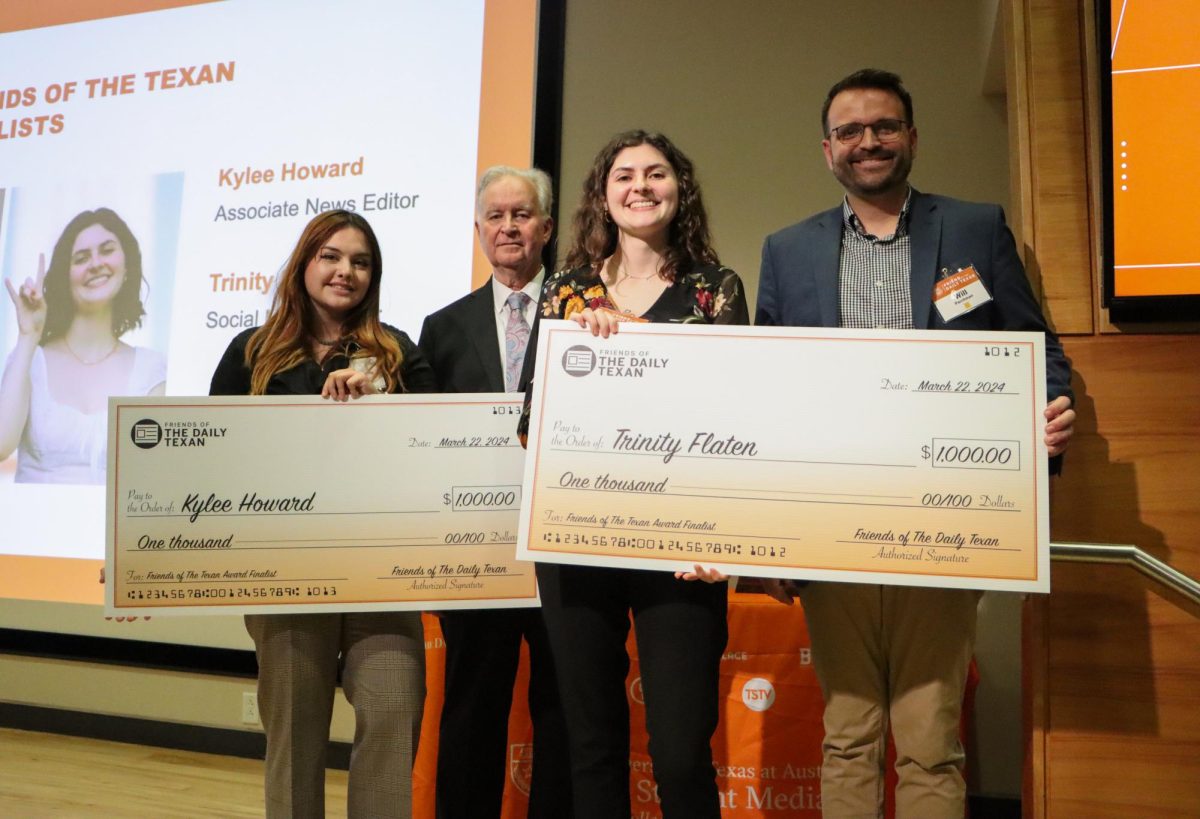
Daily Texan alumna Hayley Fick (BS ’15) says the coolest part of her job at NASA is working directly with astronauts, encouraging them to support NASA’s web campaigns, and helping them to develop media content and find a voice on social media.
Fellow alumna Mona Behnaz Maali talked with Fick about her new position as a social media manager at the Johnson Space Center in Houston and how she built on the semesters of experience she gained in The Daily Texan newsroom, as well as her internships and classroom experience as a public relations major at The University of Texas at Austin.
Fick joined The Daily Texan’s expanding web team at a time when the paper was undergoing many changes, and in her role, she helped the staff deliver news online and increasingly in real time. She eventually served as an associate web editor, digital director and director of technical operations at The Texan. She was also a communications intern at the Cockrell School of Engineering, where she saw firsthand how students benefited from research funded by NASA, where she interned her senior year. She shares the valuable insights she’s gained along the way.
Tell me about some experiences that shaped the person you were coming into UT as a freshman.
I grew up right outside of Houston in Montgomery, Texas. I was interested in NASA and space travel as early as the third or fourth grade. I remember my Girl Scout troop had an overnight lock-in at the Space Center in Houston, in the visitors’ center. I was always interested, but I think more so in the science side of things, just because I thought that was the only way you could work at NASA. I didn’t know there were other kinds of careers.
In high school, I was really involved in debate, and I also did newspaper in high school. I lived in Austin from about the fifth through the seventh grade and liked Austin. I wanted to go to a school that offered a wide range of majors and would give me the freedom to change my major if I wanted to. That was a big part of my decision to come to UT.
During your time at The Texan, the paper underwent important changes. The TSM board considered the controversial decision to cut down print production of The Texan. It was also the time that Friends of The Daily Texan was established to help preserve The Texan’s legacy. Can you tell me about some of the changes you witnessed during this time?
I was pretty heavily involved in the process to decide whether to print or not print every day of the week. I understood the value of a print edition, but I also saw that we had no funding to improve our website or improve any of our digital offerings. I think people were hesitant to explore any sort of online or digital ads. We had some website banner ads, but it wasn’t very much. One of the big topics emerging at that point was the use of native advertising. We had to consider if we could produce some paid editorial pieces and the ethical issues that could be involved with that.
I think the biggest part of the struggle was changing the advertising model to suit the new platform. It was a very big deal, and I remember going to some heated board meetings. A lot of people on the board were very open-minded, but the finances were the tricky part. No one was really able to forecast if changing the advertising model would allow us to make money to print the paper once a week. I knew the students wanted to improve and try new things, and I saw them trying new things all the time, but we just couldn’t rearrange the way we were investing in it to make way for our digital online offerings. Part of the problem was getting the advertising staff at TSM to get behind selling ads in a different way than they were used to.
What did you learn in your time at The Daily Texan that helps you in your job today?
In a lot of the work at The Daily Texan, we asked, “How can we do this more efficiently?” Because we didn’t have a lot of resources. We didn’t have a lot of manpower or time or money to make this project happen. Honestly, the government is very similar. Creating with efficiency in mind is a big, big, big part of my job. I would say that’s what my bosses are always looking for — how much time went into making this piece of content versus how many views we got off of it and how many engagements we got from it.
If content is not performing well, it’s okay to ditch it and spend your resources on content that does well. For example, we have a NASA TV channel in which we broadcast spacewalks and launches, and there’s also a web stream. One of the programs we had was a daily 30-minute live broadcast show hosted in Mission Control that featured daily news of what was happening on the space station. A lot of time resources were going into creating this show, called “Space Station Live.” A lot of the content did not generate views, especially when shared on the web. We all decided as a group this past year in my office to ditch it.
We have so many talented TV people and videographers that were tied up every day on this live TV show that no one really watched. It was pretty awesome to liberate those really talented people to actually make some products that now perform very well.
And how did your classroom experiences in the communication school shape your path?
I feel now that when I pitch journalists or I’m working with journalists, I understand their viewpoint because I’ve worked with so many. A lot of people I work with at NASA are former journalists. I am one of the few people in our office that has a public relations background. A lot of the people in my office, because they are journalists, don’t really think of content as a campaign, where you have a goal in mind and you have things you want to measure. It just isn’t their first instinct to ask, “Who am I targeting with this content, and how well did it do?” I feel that’s something I really took from my education, so I’ve brought that spirit to the newsroom at NASA.
Where do you foresee your professional path taking you in the coming years?
I am happy with my job at NASA. I would obviously love to be here at the time we go to Mars and to be involved in creating that announcement — that would be amazing.
I’ve worked with so many talented people over the years, especially at UT. It’s really exciting to think about one day building a team with those people. I would love to do what I do now on a bigger scale someday and to have my own PR firm. At The Daily Texan, I felt we had a lot of agency in building our own teams, and that’s something that I really miss.
As a PR professional, I have always wanted to work for clients that I personally really value. I’ve never wanted to work for just any client. Whatever I do, I always want to work for something that I believe in personally — so if I’m not at NASA, then maybe I would advocate for scientific research or environmental research.
What message would you like to share with your past Texan colleagues?
Consider a career at NASA. It’s something I always stress, that there are communications jobs at NASA and in other technical fields. I think they’re overlooked sometimes by communications professionals just because the field is technical. A lot of people don’t even consider NASA. For me, it’s been such a great place to work, and I share that as much as I can.
Mona Behnaz Maali served at The Daily Texan for six semesters from 2005 to 2007, as a general reporter, senior reporter, page designer and associate news editor. After graduation, she led the Austin chapter of the National Stuttering Association for four years and was recognized nationally for her leadership within the stuttering community. She also compiled and edited a book for the National Stuttering Association called Turning Points.


